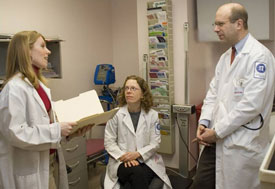New York's economy profits from Fogarty support
May / June 2012 | Volume 11, Issue 3

Photo courtesy of SUNY Downstate Medical Center
Dr. Jack A. DeHovitz (right) of the State University
of New York (SUNY) Downstate Medical Center
has trained scores of scientists through a Fogarty
AIDS International Training and Research Program
(AITRP) grant.
Fogarty’s research training funds are just a small portion of the NIH dollars awarded to New York organizations but they can have a significant impact. Longtime Fogarty grantee, Dr. Jack A. DeHovitz of State University of New York (SUNY) Downstate Medical Center, has used his grants to train scores of scientists in techniques needed to combat the spread of sexually transmitted diseases (STDs) in developing countries.
In order to prevent and treat diseases such as hepatitis and HIV/AIDS, he has taught researchers how to conduct diagnostic tests, analyze risk factors for transmission and assess the attitudes and behavior of adolescents, including condom use.
"Fogarty has funded AIDS research training for an area that critically needed it, that is, Central and Eastern Europe, which has the most rapidly rising epidemic now. We have been able to train more than 80 trainees who have gone back to provide key leadership in the nine or 10 countries in that region that have been devastated by the disease," DeHovitz said.
He noted that New York state’s economy has benefitted from his grant funds in several direct ways, including faculty and staff salaries; university fees; supplies, travel and conference costs; and trainee stipends and accommodation.
DeHovitz stressed that any federal budget cuts would have "a dramatic impact," even within his own institution, where the ongoing training of eight to 10 global health scientists would end.
Overall, health research funds benefit New York in many ways:
- New York received more than $2 billion in NIH grants in 2011, which supported 33,193 jobs. More than half went to New York City universities and nonprofit research centers, according to United for Medical Research Center for an Urban Future.
- New York is home to seven of the top 50 American research universities and two of the top 25 medical research universities, according to the Center for Measuring University Performance, 2010.
- The state gives a 9 percent corporate tax break to investment in research and development facilities, according to Empire State Development; R&D Credit Coalition, 2010.
- New York City has the largest biosciences workforce and the second largest life sciences workforce of any U.S. City, employing a combined 80,000 people at an average wage of $75,700, according to NYC Economic Development Corp., 2011.
More Information
To view Adobe PDF files,
download current, free accessible plug-ins from Adobe's website.